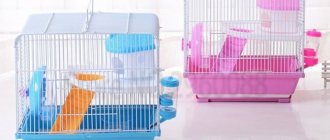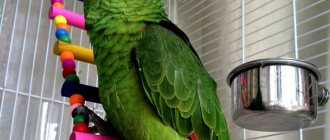- home
- Housing
11/03/2018 Some people are accustomed to keeping hamsters in jars and other similar vessels, which is a completely wrong decision, as it often leads to obesity and heart disease.
A cage for a hamster is his home, in which he will feel comfortable and cozy. The owner should pay a lot of attention to choosing a home for his pet - this is directly related to the length and quality of his life. Not all hamster cages available in pet stores are equally good and suitable for rodents. Consultants will strive to sell the most expensive product, often neglecting quality. Therefore, every owner of a little furry should know the basic criteria for choosing a home. Reading reviews on the Internet and looking at photos of cages for hamsters is, of course, useful, but it is better to make a choice in person, having carefully studied everything.
Basic parameters
In this case, size really matters. Rodents love to lead an active lifestyle, so there should be enough free space in their house. For dwarf species of rodents, the ideal size is 50x30 cm, and for Syrians, 60x40 is best. You can buy larger cages, but they will be more difficult and take longer to clean. In addition, many people get hamsters precisely because these animals take up little space. If you see huge houses in a pet store, then know that they are intended for large rodents like a chinchilla or guinea pig. For a simple hamster, such space will be unnecessary.
There are also cages with a size of 20x25. Basically, these tiny dwellings are used for short-term keeping of animals (as a quarantine room or for depositing young animals). An ordinary individual will not be able to adapt to life in a small cage purely psychologically - animals value personal space very much. They mentally divide their home into rooms (bedroom, toilet, place to play, and so on). In a small cage, animals will feel like they are in prison, and the lack of comfort will not bring them a long and happy life.
The distance between the rods also plays an important role. It should not exceed one centimeter, as large gaps will cause the hamster to escape. The rods must be strong so that the animal cannot gnaw them.
Pallet
Here the choice is usually limited to two options - a monolithic tray into which filler is poured, or models with a metal or plastic mesh at the bottom. It is better to give preference to the first option. The hamster will not be able to damage its paws during active play, and it is much easier to clean a tray with a smooth bottom.
The bottom of aquariums is always smooth, but in order to thoroughly clean your pet’s house, you will have to literally turn it upside down.
Sorry, there are no products matching your search parameters in this category.
Types of cages for rodents
You can find several types of rodent cages in various stores.
- Metal lattice is the most common and budget option.
Advantages:
- Suitable for all breeds of hamsters.
- Does not cause any hassle during cleaning and disinfection.
- It is easy to attach accessories to it.
- Well ventilated.
Flaws:
- When active, your pet makes a lot of noise.
- The house is open on all sides, which is why the animal scatters the filler outside the house.
- Iron rods can become dangerous for the animal during games.
- Plastic cage - equipped with various tunnels, running wheels and other places where the rodent can have fun. This is not the best option for large breeds of hamsters; plastic cages with a partition are best suited for dwarfs and dwarfs.
- Aquarium - made of glass and suitable for small rodents. Currently, such cells are used extremely rarely. A home with panoramic glass will allow you to easily observe the animal around the clock.
Advantages:
- Cleanliness - the furry animal will not be able to scatter its litter outside the cage.
- Good sound insulation.
- The hamster is protected from other animals living in the apartment, if any.
- It will be convenient for the owner to monitor his pet.
Flaws:
- This model is heavier in weight.
- You will have to wash it often as the glass gets dirty easily.
- The house is not constantly ventilated, meaning the hamster will be deprived of a constant flow of fresh air.
- It will be quite difficult to position and secure the equipment.
- Plastic dune - this option has a plastic bottom, transparent walls and a metal grill on top that provides good ventilation. Such a home for a rodent is easy to clean, the filler will not fall out of it, and nothing prevents the owner from watching his pet.
The most popular companies producing enclosures and accessories for rodents are Ferplast, Triol, Zolux. For more space, your hamster will want a two-story cage or a three-story cage.
ZOLUX RODY MINI
The cage is made of metal and high-quality plastic. Its dimensions - 21-18*33 cm allow you to install the cage on any tabletop surface. The cage comes with a 75 ml bottle, a wheel, a feeder, 2 flat plugs and another wheel. There is a choice of cage colors on sale, which will allow you to match it to the design of the room. A tall plastic tray will keep the room free of sawdust.
Pros:
- There is a choice of cage color;
- Good equipment;
- Quality materials.
Minuses:
- Suitable for dwarf hamsters only.
How to connect two hamster cages
Often, owners buy two small houses for a pet rodent, which become small as the animal grows up. Then the owner begins to think about how to combine two homes into one in order to save on buying a new one? Everything is very simple.
Lattice cages are connected by “biting out” rods or an entire wall and then fastening them with wire to another cage. This method is preferable because it does not incur any costs. In addition, hamsters will appreciate the expansion horizontally rather than vertically.
There is a way to expand the territory of a hamster’s residence without damaging the integrity of the cells. Some companies produce models that initially have a special hole for attaching a pipe. This way, the two cages will be connected by a tunnel, and the hamster can move between them without any obstacles. The main thing is not to forget about the diameter of the pipe - it must correspond to the size of the hamster, otherwise the animal may get stuck.
What else is needed for a hamster to be completely happy?
In addition to the mandatory attributes of the cage, some other little things are needed that will allow the hamster to feel cheerful and healthy.
A container with sand or a special closed bath for rodents. This is necessary because hamsters cannot be washed with water. They bathe in fine, clean sand. This sand can be bought at a pet store and poured into a special bathing suit or just a deep bowl. Hamsters enjoy wallowing in the sand, and you will immediately notice an improvement in the condition of your pet's coat.
Sand bath
Hamsters love it when branches of various edible trees, for example, apple trees, are placed in their cage. This is a source of vitamins for your pet and an opportunity to sharpen your teeth.
Hamsters love to chew on branches
treat for hamsters will be an excellent gift for your pet . As a rule, it is a stick covered with various goodies: grains, dried fruits, grass, etc. But there are also treats of other shapes, for example, in the form of a pipe. Treats are hung with special mounts that come with the kit, either from the ceiling or from the wall of the cage.
Treats for the hamster on the wall of the cage
How much does a hamster cage cost?
Basically, the price of houses depends on their size and configuration. The cheapest cages for hamsters cost from five hundred rubles, but they are worth keeping in case finances are really tight.
The cost of the most sophisticated cells starts at seven thousand. As an option, you can make a custom-made house for your pet - a full flight of imagination and an empty wallet are guaranteed.
There is the following price/quality ratio:
- Lattice model with a plastic bottom - from one to eight thousand;
- Lattice, but made of wood - about six thousand rubles.
- Aquarium - from four thousand.
- Dune - prices vary from two and a half to six thousand.
- To order - from four to twenty-seven thousand rubles (if your imagination doesn’t take you even further).
Basically, a good fully equipped house will cost the owner 2000–4000 rubles.
You can buy used models. But it is worth remembering that a wooden cage can only be new, since it is not possible to disinfect it, and disinfection after the previous owner is a mandatory process.
Often people are faced with the fact that enclosures for hamsters cost many times more than the animals themselves. Some people are not willing to spend that much money on their pets. Alternatively, you can buy a cheap, simple, but spacious cage. The rodents themselves will not appreciate either the color scheme or the aesthetics of their home. What is important for them is sufficient space, which they can arrange for themselves.
SAVIC SPELOS XL METRO
The unusual design of the cage for hamsters is presented in the form of a plastic two-tier box. On the second level there is a figured shelf, which has holes for a drinking bowl, wheels and a feeding bowl. The transparent tunnel comes out and is strong enough for the hamster to chew through it. The box itself is quite large - 59*37*26, which allows you to purchase a similar product for the Syrian hamster.
Pros:
- Large and roomy box;
- Suitable for large hamsters;
- Good equipment;
- High animal safety.
Different breeds have different standards
Syrians and Dzungarians differ from each other in size and behavior. Therefore, they require different cells.
Djungarian hamsters
This breed is famous for its increased activity. Djungarians run a lot, so it is better to put a running wheel in their house. The dwelling must be securely closed, and the distance between the bars must not exceed the norm.
Buy houses for the Djungarian breed with a good ventilation system, otherwise a toxic odor will begin to accumulate inside.
Syrian hamsters
Compared to other breeds, the Syrian is a rather large animal, so it needs appropriate housing. The size 35x20, often found in poultry markets, will not suit the Syrian rodent, as it will be too small for him. Large houses are perfect for such hamsters.
The distance between the rods should be 5 mm, because the cubs of this breed in the first days of life are able to squeeze into seven-millimeter gaps.
INTER-ZOO G-020 TEDDY II
A large cell is 37*25*51, where 51 is the height. Thanks to the similar structure of the cage, it is well suited to different breeds of hamsters and a lot of different accessories can be placed inside it. The cage includes spring tunnels, ladders, a drinking bowl, a feeder, and a wheel. The tray can be detached and washed, which is convenient and comfortable. Each floor is equipped with a door, making them easy to clean.
Pros:
- High cage;
- Suitable for large breeds of hamsters;
- The set comes with many accessories;
- There is space for installing additional accessories;
- Additional doors on each tier.
How much does a hamster cost along with a cage?
In various groups or ad sites you can often see people selling cages with their pets. The thought immediately arises: will such a purchase be profitable? Certainly!
If you buy the animal together with the house second-hand, this pleasure will cost 2–2.5 thousand. Agree, definitely a budget option.
If you buy a standard cage with a hamster, which costs about five hundred rubles, in a specialized pet store, then you can spend 3–3.5 thousand. This is quite small compared to other animals. In addition, further maintenance of the rodent will be cheap, which makes these small animals one of the most budget-friendly pets.
Design
This aspect can be divided into three additional ones.
Possibility of disassembly
You will have to clean the cage at least a couple of times a week, so the more convenient it is, the better. The ideal option is detachable models, which allow you to literally “unfasten” the grille from the pallet with one movement and gain convenient access inside.
Aquariums, which are also used by some owners to keep rodents, perform the worst in this regard. Looking ahead, it is worth noting that the aquarium was not originally intended and is poorly suited for a comfortable life for hamsters.
Where to put a hamster cage
The place where the house will stand is very important for the animal’s subsequent residence. Hamsters do not perceive changes in environment well, therefore, if possible, it is necessary to choose a place from which the house will not move in the future.
You cannot place a rodent’s home in a draft, otherwise the animal will blow out, and treating a cold is not the most exciting activity. It is also important to protect this place from direct sunlight, but you should not place it next to the curtains - the hamster will tear the fabric. There should be no radiators or other heating devices nearby. Houseplants need to be kept away - rodents are quite curious and can chew on everything they can reach.
The temperature in the room is not lower than twenty degrees, the room must be ventilated often. Do not allow other pets near hamsters. In addition, the cage should be located away from noise sources such as radio and television, as this can be stressful for the rodent.
Of course, a pet’s house cannot be placed on the floor; it must be on a hill (table, chest of drawers). Hamsters live by instinct, so they perceive everything that is located above as a threat to life.
A good option for the location of the cage would be the bedroom. But here take into account the fact that these animals are active mainly at night. If the rustling interferes with your sleep, the house will have to be rearranged.
Size
In nature, in their natural habitat, hamsters of all breeds are extremely active and energetic, because their life directly depends on the ability to run quickly: they need to go scouting for new food, collect it and take it to their burrow, simultaneously escaping from a predator.
Pets do not need to do all this, but nature takes its toll and requires that energy be spent moving around the cage; accordingly, the rodent should have enough space for this. In addition, he will need separate areas for toileting, eating, sleeping and storing supplies.
The recommended cage size for keeping one individual is 30x30x45, but more is possible. If you are limited in space, you can take a closer look at two-story options, but young and active animals often fall from the second floor, which can lead to injury.











